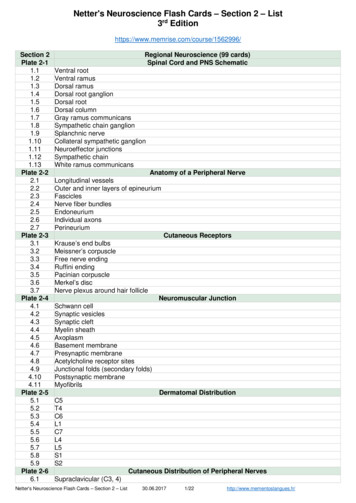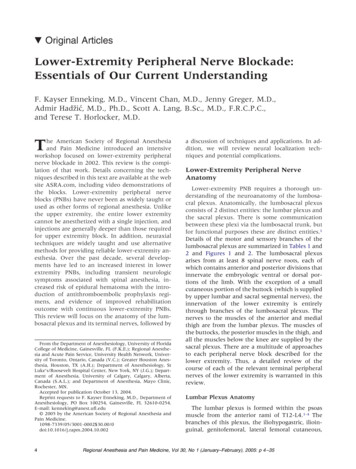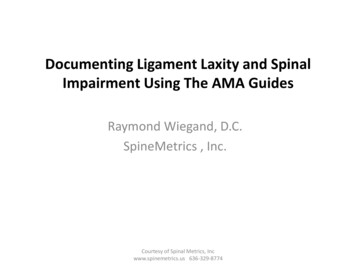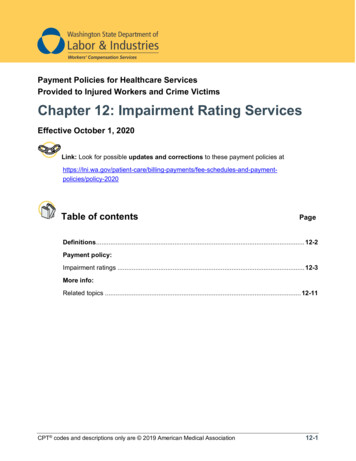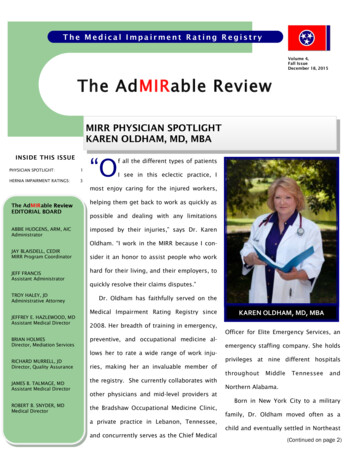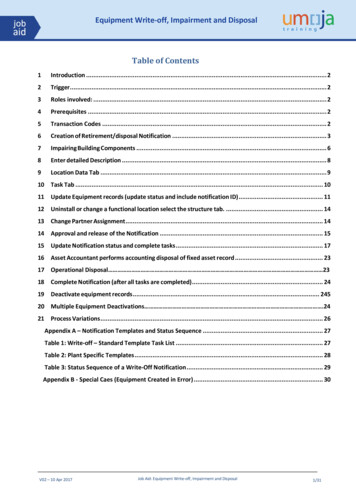
Transcription
3-700 Exhibit 4July/August 2009In this issueRating Spinal Nerve ExtremityImpairmentDegenerative Disk DiseasePub Med CitationsIn upcoming issuesExaminee Reported HistoryComplex Regional PainSyndrome UpdateRating by Analogy: Abusing theGuides Fifth Edition: ReflectionsComparison of Two Jurisdictions:California vs HawaiiLower Extremity TrainingWorkbook Questionsand AnswersBook Review: Guides to theEvaluation of Disease and InjuryObservations on the SixthEdition: Improvement inImpairment AssessmentThe Guides, Sixth hasbeen reprinted!The Guides to the Evaluationof Permanent Impairment, SixthEdition, has been reprintedto incorporate updates to theoriginal edition—all found in theClarifications and Correctionsdocument released in 2008.The reprinted books have beenshipping since June 1, 2009,but please e-mail guides6@ama-assn.org with anyquestions or concerns.Reproduced with permission of the AMARating Spinal Nerve Extremity ImpairmentUsing the Sixth EditionChristopher R. Brigham, MDThe Sixth Edition of the Guides did not provide a separate mechanism for rating spinalnerve injuries as extremity impairment; radiculopathy was reflected in the spinal ratingprocess outlined in Chapter 17, The Spine and Pelvis. Certain jurisdictions, such asthe Federal Employee Compensation Act (FECA), rate nerve root injury as impairment involving the extremities rather than as part of the spine. For example, a patientmay have a spinal injury resulting in a radiculopathy; under FECA, only the impairment resulting from the radiculopathy (ie, the spinal nerve injury) would be rated.The Fifth Edition provided a procedure to assess isolated spinal nerve root impairment,since this was part of the rating system in the range of motion method; however, thiswas not provided in the Sixth Edition as the range of motion method was discarded.This article presents an approach to rate spinal nerve impairments consistent with theSixth Edition methodology. This approach should be used only when a jurisdictionmandates ratings for extremities and precludes rating for the spine.Sixth Edition Rating Process for Peripheral Nerve InjuriesIt is helpful to first understand the methodology used in the Sixth Edition to ratefor peripheral nerve impairment and how it relates to the Fifth Edition. The clinicalassessment process is similar in the two editions; however, the approach to assessingimpairment was modified in the Sixth Edition for consistency with the change inmethodology. In the Fifth Edition the rating of upper extremity peripheral nerve injuries involved the use of 3 tables. Maximum losses are obtained by using Table 16-15,Maximum Upper Extremity Impairment Due to Unilateral Sensory or Motor Deficitsor to Combined 100% Deficits of the Major Peripheral Nerves (5th ed, 492). Sensorydeficits are graded by using Table 16-10, Determining Impairment of the UpperExtremity Due to Sensory Deficits or Pain Resulting From Peripheral Nerve Deficits(5th ed, 482). Motor deficits are determined by using Table 16-11, DeterminingImpairment of the Upper Extremity Due to Motor and Loss-of-Power DeficitsResulting From Peripheral Nerve Disorders Based on Individual Muscle Rating(5th ed, 484).For example, if a patient had peripheral nerve sensory involvement of the axillarynerve that is assigned according to Table 16-15 (5th ed, 492) a maximum of 5% upperextremity impairment (UEI), and the patient had a grade 3 (moderate) sensory deficit from Table 16-10 (5th ed, 482), which is associated with a 26% to 60% deficit,the impairment could range from 1% UEI (ie, 26% 5% UEI) to 3% UEI (ie, 60% 2009 American Medical Association.No part of this publication may be reproduced, stored in a retrieval system, or transmitted, in any form or by any means, electronic,mechanical, photocopying, recording, or otherwise, without the prior written permission of the publisher.
3-700 Exhibit 4The Guides NewsletterAdvisory BoardEditorChristopher R. Brigham, MDPortland, MaineAssociate EditorsJames B. Talmage, MDCookeville, TennesseeCraig Uejo, MD, MPHSan DiegoEditorial BoardGunnar B.J. Andersson, MDChicago, IllinoisMarjorie Eskay-Auerbach, MD, JDTucson, ArizonaRobert J. Barth, PhDChattanooga, TennesseeCharles N. Brooks, MDBellevue, WashingtonLorne K. Direnfeld MD FRCP(C)Kahului, HawaiiLeon H. Ensalada, MD, MPHWaitsfield, VermontMark Hyman, MDLos Angeles, CARichard T. Katz, MDSt. Louis,MissouriMark Melhorn, MDWichita, KansasVert Mooney, MDSan Diego, CaliforniaKathryn Mueller, MDUniversity of ColoradoGlenn B. Pfeffer, MDLos Angeles, CaliforniaJames Robinson, MDSeattle, WashingtonHal Stockbridge, MDOlympia, WashingtonW. Frederick Uehlein, JDFramingham, Massachusetts2The Guides Newsletter, July/August 2009Reproduced with permission of the AMA 5% UEI). The final impairment assignment would be based on the judgment ofthe physician.In the Sixth Edition, Table 15-14, Sensory and Motor Severity (6th ed, 425), definesthe severity for sensory and motor deficits. The relationship between this table andthe upper extremity tables, Table 16-10 (5th ed, 482) and Table 16-11 (5th ed, 484),are presented in Table 1.In the Sixth Edition, once the evaluator defines the sensory and/or motor deficits onthe basis of the descriptions in Table 15-14 (6th ed, 425), Table 15-21, PeripheralNerve Impairment: Upper Extremity Impairments (6th ed, 436-444), is used to identify the potential impairments on the basis of the severity of the deficit. Using theexample of a moderate sensory deficit of the axillary nerve, Table 15-21 (6th ed,436) notes that the default impairment is 2% UEI and may range from 1% to 3%UEI. The impairment values are identical in the Fifth and Sixth Editions. In theSixth Edition, the physician does not multiply the extent of the deficit against themaximum value assigned to the nerve; rather, the physician identifies the severityand proceeds directly to Table 15-21 (6th ed, 436) for the associated impairmentvalues. Rather than using clinical judgment to assign the potential impairmentwithin a range (for example, with a moderate sensory deficit of the axillary nerve, arange of 1% to 3% UEI), with the Sixth Edition the physician uses the adjustmentprocess to determine which specific impairment is assigned.The values assigned to Table 15-21, Peripheral Nerve Impairment: Upper ExtremityImpairments (6th ed, 436-444), and Table 16-12, Peripheral Nerve Impairment:Lower Extremity Impairments (6th ed, 534-536), were obtained directly from thevalues assigned in the Fifth Edition, ie, Table 16-15, Maximum Upper ExtremityImpairment Due to Unilateral Sensory or Motor Deficits or to Combined 100%Deficits of the Major Peripheral Nerves (5th ed, 492), and Table 17-37, ImpairmentsDue to Nerve Deficits (5th ed, 552). The maximum loss for each nerve is the samein the Fifth and Sixth Editions. The impairment values for the severity of the deficit (ie, mild, moderate, severe, and very severe) were obtained by determining therange of impairments that would be associated with Fifth Edition ratings. As noted,with a moderate sensory deficit, in the Fifth Edition the multiplier would be between26% and 60%; therefore, to provide the 5 unit values for a moderate sensory deficit in the Sixth Edition, the maximum impairment value for that nerve (obtainedfrom the Fifth Edition) would be multiplied by 26%, 34.5%, 43%, 51.5%, and 60%,ie, yielding the values (if there was a maximum loss of 5%) of 1% UEI, 2% UEI, 2%UEI, 3% UEI, and 3% UEI. At times, the values would be modified to reflect theminimum and maximum values assigned to a class.In the Sixth Edition, impairment for radiculopathy is reflected in the diagnosis-basedimpairment (DBI) for the spinal region. In developing an alternative approach torating isolated radiculopathy, it is important to provide consistency in impairmentratings among the chapters. An individual with an intervertebral disk herniationwith documented resolved radiculopathy or nonverifiable radicular complaints at theclinically appropriate levels present at the time of examination is assigned a class 1impairment. If there is an intervertebral disk herniation at a single level with documented radiculopathy, class 2 is assigned, and for intervertebral disk herniations atmultiple levels with multiple-level or bilateral radiculopathy, class 4 is assigned.Cervical spine intervertebral disc herniations are rated per Table 17-2, CervicalSpine Regional Grid: Spine Impairments (6th ed, 564-566); the default, grade C,impairment for class 1 is 6% whole person impairment (WPI); for class 2, 11%WPI; and for class 4, 28% WPI. Therefore, one can conclude that the incrementalimpairment for a cervical spine single-level, 1-sided radiculopathy is 5% WPI (eg,11%–6%) and the maximum incremental impairment for a multiple-level radicu-
3-700 Exhibit 4Reproduced with permission of the AMARating Spinal Nerve (continued)lopathy is 22% WPI (eg, 28%–6%). A 5% WPI per Table15-11, Impairment Values Calculated From Upper ExtremityImpairment, is equivalent to 8% or 9% UEI; therefore, the maximum impairment for an isolated single-level, 1-sided cervicalradiculopathy would be 9% UEI. The maximum impairment formultiple-level or bilateral radiculopathy would be 37% UEI.In a similar manner, lumbar spine intervertebral disc herniations are rated per Table 17-4, Lumbar Spine Regional Grid:Spine Impairments (6th ed, 570-574); the default, grade C,impairment for class 1 is 7% WPI; for class 2, 12% WPI; andfor class 4, 29% WPI. Therefore, one can conclude that theincremental impairment for a cervical spine single-level,1-sided radiculopathy is 5% WPI (eg, 12% –7%) and themaximum incremental impairment for a multiple-level radiculopathy is 22% WPI (eg, 29% –7%). A 5% WPI per Table16-10, Impairment Values Calculated From Lower ExtremityImpairment, is equivalent to 12% or 13% lower extremityimpairment (LEI); therefore, the maximum impairment foran isolated single-level, 1-sided lumbar radiculopathy wouldbe 13% LEI. The maximum impairment for multiple-level orbilateral radiculopathy would be 56% LEI.Applying the Peripheral Nerve Rating Processto Develop Spinal Nerve Rating TablesWith an understanding of the approach used to developthe rating process for peripheral nerve injuries in the SixthEdition, it is possible to develop spinal nerve rating tablesbased on the Fifth Edition, ie, Table 15-17, Unilateral SpinalNerve Root Impairment Affecting the Upper Extremity (5thed, 424) (also presented as Table 16-13, Maximum UpperExtremity Impairment Due to Unilateral Sensory or MotorDeficits of Individual Spinal Nerves or to Combined 100%Deficits [5th ed, 489]), and Table 15-18, Unilateral SpinalNerve Root Impairment Affecting the Lower Extremity (5thed, 424). Most spinal nerve roots (except C6) have a maximum loss of function due to sensory deficit or pain of 5%extremity impairment; this is the same magnitude of impairment provided to the previous example of rating the axillarynerve by the Fifth and Sixth Editions, ie, a moderate sensorydeficit of any spinal nerve root (except C6) would range from1% to 3% extremity impairment.The maximum motor deficits are capped at 9% UEI and13% LEI to achieve consistency with the Sixth Edition’sChapter 17, The Spine and Pelvis. From a practical perspective this is not problematic, since, in the context in whichthe Guides are used, it is rare to see motor weakness moresevere than “mild” (grade 4/5, which reflects decreased weakness with some resistance). A moderate weakness, grade 3/5,reflects movement against gravity only without resistance,and a severe weakness, grade 2/5, reflects movement withgravity eliminated. The combined sensory and motor impairment cannot exceed 9% UEI or 13% LEI, and the combinedimpairment for multiple-level or bilateral radiculopathycannot exceed 37% UEI or 56% LEI.The proposed new tables that follow (Spinal NerveImpairment: Upper Extremity Impairments; and SpinalNerve Impairment: Lower Extremity Impairments) provide values for rating spinal nerve impairment by means ofthe process defined for the Sixth Edition in rating peripheral nerve injuries. Due to the need for consistency with theSixth Edition’s Chapter 17, The Spine and Pelvis, all impairment values are class 1.The Sixth Edition, page 430, explains the process for theupper extremity (the lower extremity process is similar):a. In the left column identify the nerve involved andthen identify the severity of the sensory and/ormotor deficit.b. Adjust the impairment as described in Section 15.3,Adjustment Grid and Grade Modifiers: Non-KeyFactors, excluding Table 15-8, Physical ExaminationAdjustment, since these neurologic examination findings define the impairment values in Table 15-20.Adjustments are made only for functional history(Table 15-7) and clinical studies (Table 15-9) (ie,electrodiagnostic studies)c. Combine motor and sensory impairments at theUEI value.This same process can be used with the new proposedtables. The correct column and row are identified. The ratings for the sensory component and the motor componentare adjusted for functional history and for clinical studies(if electromyography was performed when the patient wasnear maximum medical improvement). The sensory and themotor ratings are combined.For example, assume a patient had a C8 radiculopathy thatresulted in a mild sensory deficit and mild motor deficit, witha functional history per Table 15-7 (6th ed, 406) consistentwith grade modifier 2 and electrodiagnostic studies per Table15-9 (6th ed, 410) consistent with grade modifier 1. Boththe sensory and motor deficits are class 1, associated with adefault grade C value of 1% UEI for the sensory deficit and6% UEI for the motor deficit. The functional history is 1higher than the class, but the clinical studies are the same asthe class; therefore, the adjustment is 1, resulting in grade Dand assignment of the value immediately to the right of thedefault grade. The final impairment would be 1% UEI for thesensory deficit and 9% UEI for the motor deficit, resulting ina combined 10% UEI.ConclusionTables have been developed for the spinal nerves by meansof the methodology defined in the Sixth Edition. By usingthese tables and the process defined in the Sixth Edition, itis possible to rate spinal nerve impairments for jurisdictionsthat do not permit rating for the spine and require rating forradiculopathy as an extremity impairment.The Guides Newsletter, July/August 20093
3-700 Exhibit 4Reproduced with permission of the AMARating Spinal Nerve (continued)TabTable 1. Comparison of Sensory and Motor Deficits: Sixth Edition and Fifth EditionSixth EditionDescriptionFifth EditionFifth EditionNumericSensory GradeSensory Deficit (%)Motor GradeMotor Deficit Severe3261-80251-75Very severe orcomplete loss41/081-1001/076-100Proposed Table 1. Spinal Nerve Impairment: Upper Extremity ImpairmentsImpairmentClassClass 0Class 1Class 2Class 3Class 4ImpairmentRanges (UEI)01-13% UEI14% - 25% UEI26% - 49% UEI50% - 100% UEIAAAGrade4ABCDEC5000111Mild sensory deficit12233Moderate sensory deficit33444Severe sensory deficit44555Very severe sensory deficit02468Mild motor deficit89999Moderate motor deficit99999Severe or very severemotor deficitC6001122Mild sensory deficit23345Moderate sensory deficit55666Severe sensory deficit67788Very severe sensory deficit02579Mild motor deficit99999Moderate motor deficit99999Severe or very severemotor deficitC7000111Mild sensory deficit12233Moderate sensory deficit33444Severe sensory deficit44555Very severe sensory deficit02579Mild motor deficit99999Moderate, severe, or verysevere motor deficitThe Guides Newsletter, July/August 2009BCDEBCDEBCDE
3-700 Exhibit 4Reproduced with permission of the AMAProposed Table 1 (cont.) Spinal Nerve Impairment: Upper Extremity ImpairmentsImpairmentClassClass 0ImpairmentRanges (UEI)GradeClass 1Class 2Class 3Class 41-13% UEI14%-25% UEI26%-49% UEI50%-100% UEIABCDEAC8000111Mild sensory deficit12233Moderate sensory deficit33444Severe sensory deficit44555Very severe sensory deficit03699Mild motor deficit99999Moderate, severe, or verysevere motor deficitT1000111Mild sensory deficit12233Moderate sensory deficit33444Severe sensory deficit44555Very severe sensory deficit01345Mild motor deficit56899Moderate motor deficit99999Severe or very severemotor deficitBCDEABCDEABCDEProposed Table 2. Spinal Nerve Impairment: Lower Extremity ImpairmentsImpairmentClassClass 0Class 1Class 2Class 3Class 4ImpairmentRanges (LEI)01-13% LEI14% - 25% LEI26% - 49% LEI50% - 100% LEIAGradeL30BCDEABCDEABCDEABCDE00111Mild sensory deficit12233Moderate sensory deficit33444Severe sensory deficit44555Very severe sensory deficit01345Mild motor deficit56891Moderate motor deficit13 13 13 14 15Severe or very severemotor deficitThe Guides Newsletter, July/August 20095
3-700 Exhibit 4Reproduced with permission of the AMARating Spinal Nerve (continued)Proposed Table 2 (cont.) Spinal Nerve Impairment: Lower Extremity ImpairmentsImpairmentClassClass 0Class 1Class 2Class 3Class 4ImpairmentRanges (LEI)01-13% LEI14%-25% LEI26%-49% LEI50%-100% LEIAGradeBCDEL4001122Mild sensory deficit23345Moderate sensory deficit55666Severe sensory deficit67788Very severe sensory deficit02579Mild motor deficit911 13 13 13Moderate, severe, or verysevere motor deficitL5001122Mild sensory deficit23345Moderate sensory deficit55666Severe sensory deficit67788Very severe sensory deficit03579Mild motor deficit13 13 13 13 13Moderate, severe, or verysevere motor deficitS1000111Mild sensory deficit12233Moderate sensory deficit33444Severe sensory deficit44555Very severe sensory deficit01345Mild motor deficit568910Moderate motor deficit13 13 13 13 13Severe or very severemotor deficitABCDEABCDEABCDEditorial Comment: All articles in the Guides Newsletter are peer reviewed. This article was reviewed by contributors to the musculoskeletal and nervous system chapters of the Sixth Edition, including Lorne Direnfeld, MD,Marjorie Eskay-Auerbach, MD, JD, Mark Melhorn, MD, Richard T. Katz, MD, James B. Talmage, MD, and CraigUejo, MD, MPH.6The Guides Newsletter, July/August 2009E
imum loss of function due to sensory deficit or pain of 5% extremity impairment; this is the same magnitude of impair-ment provided to the previous example of rating the axillary nerve by the Fifth and Sixth Editions, ie, a moderate sensory deficit of any spinal nerve root (except C6) would range from 1% to 3% extremity impairment.
